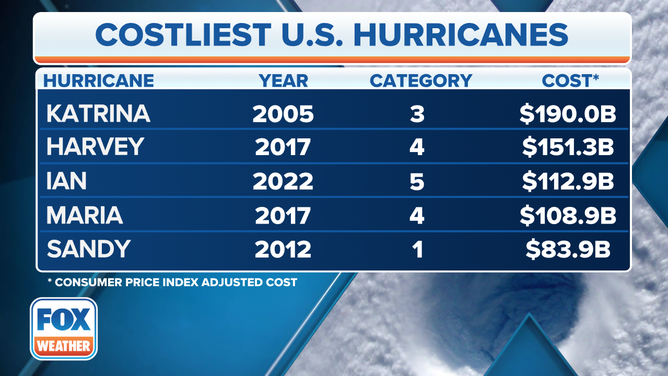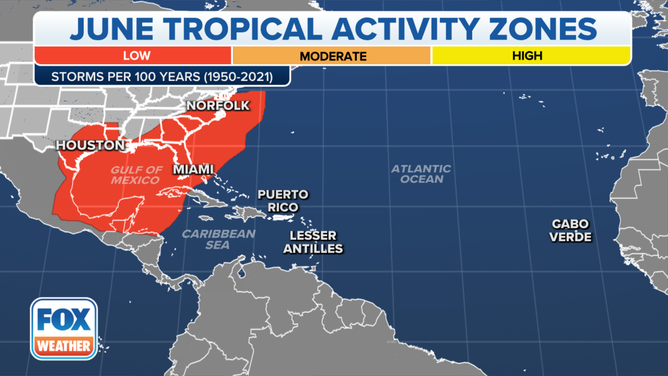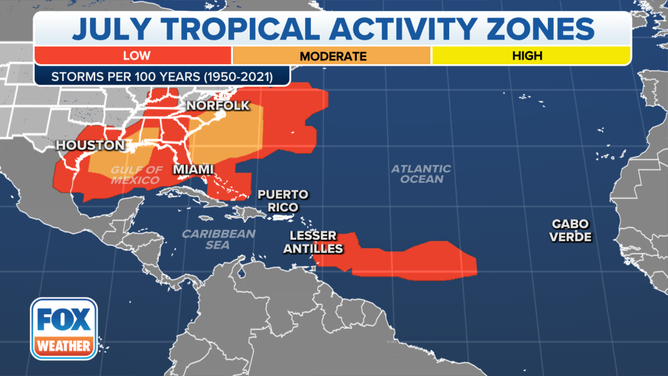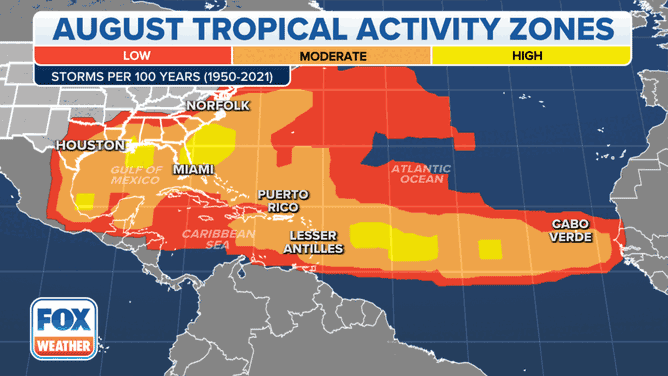What is the Main Development Region (MDR) of the North Atlantic Ocean?
Large-scale climate patterns such as the El Niño Southern Oscillation (ENSO), the Atlantic Meridional Mode (AMM) and the Atlantic Multidecadal Oscillation (AMO) can impact how active the MDR is during a season. The first hurricane of a season typically forms in the MDR in August, and the first major cyclone usually forms in September.
How do hurricanes get their names?
FOX Weather Meteorologist Kiyana Lewis explains how the World Meteorological Organization manages the names we give to hurricanes and tropical storms.
The Main Development Region of the Atlantic Ocean runs from Africa to the Caribbean Islands and is an area where the majority of tropical cyclones form.
There is not a scientific standard for the MDR, so some hurricane forecasters consider parts of the Caribbean as being a portion of the region.
The area is annually home to some of the warmest water, allowing tropical cyclones to develop quickly during the heart of the hurricane season.
Climatologists estimate that 85% of major hurricanes and 60% of all other tropical cyclones form in either the Caribbean or the Atlantic MDR.
Hurricanes such as Dorian (2019), Irma (2017), Matthew (2016) and Ivan (2004) were long-track cyclones that developed in the MDR and impacted the U.S.

Main Development Region of the North Atlantic Ocean map
(FOX Weather)
RARITY OF JUNE HURRICANES: ONLY 2 HAVE FORMED EAST OF CARIBBEAN ISLANDS IN HISTORY
The MDR consists of the region between 20 degrees north latitude and 10 degrees north latitude, as cyclones rarely venture further south.
Hurricane Matthew set the record for being the strongest cyclone at the furthest southern point in the basin in 2016. Matthew reached a latitude of 13.4 degrees north before turning northward and impacting the Greater Antilles in the Caribbean.
The first hurricane of a season typically forms in the MDR in August, and the first major cyclone usually forms in September.
These dates can fluctuate based on which climate patterns are in control.
Large-scale patterns such as the El Niño Southern Oscillation (ENSO), the Atlantic Meridional Mode (AMM) and the Atlantic Multidecadal Oscillation (AMO) can impact how active the MDR is during a season.
A La Niña cycle of the ENSO, a positive status of the AMM and a warm phase of the AMO can lead to enhanced cyclogenesis in the tropics.
During favorable atmospheric patterns, complexes of thunderstorms develop over West Africa and push into the MDR. These disturbances can develop just after splashdown in the eastern Atlantic, but if water temperatures are cool and enough Saharan dust is around, development can be delayed until the tropical waves make it closer to the Caribbean.
The region is not a favored area for development during the first months of the season due to hostile conditions that exist.
WHAT US COUNTY IS MOST IMPACTED BY HURRICANES?
The first named cyclone to ever form in the MDR was Hurricane Able, which developed in August 1950.
The year was the first season to use the alphabet to name tropical storms and hurricanes.
During the modern satellite era, tropical cyclone seasons in 1968, 1977, 1982, 1991, 1993 and 2003 produced minimal or no activity in the MDR.
Interestingly enough, four of the top five costliest U.S. hurricanes did not become significant cyclones in the MDR, meaning that the region is not a necessity for a cyclone to become a powerful disaster.
Hurricane Maria is the only cyclone out of the top five costliest disasters that developed into a significant cyclone while over the MDR.

A list of the five costliest hurricanes in U.S. history.
(FOX Weather)



